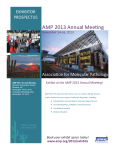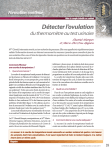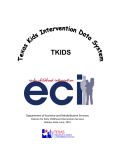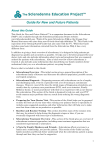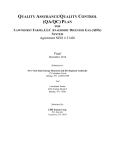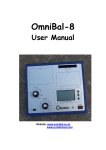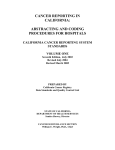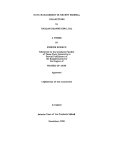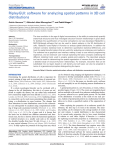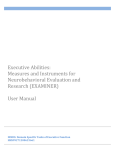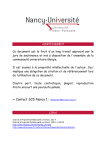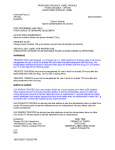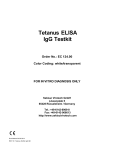Download Biointerpreter User Manual #259, 4th Cross, “Apurva Buildings”, 80
Transcript
Biointerpreter User Manual #259, 4th Cross, “Apurva Buildings”, 80 feet Road, RMV 2nd Stage, Bangalore-560094, India Telephone : +91-80-40538300/200 Telefax: +91-80-40538222 / 333 International Hotline: +1(415) 283 9698 Email: [email protected] 1 Biointerpreter User Manual Getting Started About Biointerpreter Features Highlights Overview Biointerpreter: Design and Contents User registration and Login Login Registration Login page Searching & Results Search options ● Gene Identifier types ● Paste IDs ● Study name ● P value cutoff ● Search Examples What do I get? ● Summary Report ● Explain – Categories Explanation of results Viewing the result categories & interpretation of results 2 Biointerpreter User Manual Getting Started About BioInterpreter: A web based , efficient and easy to use interpretation tool that gives quick and complete interpretation of Microarray data by significantly reducing the analysis time from hours to minutes. Features Highlights: Helps derive full value of your Microarray study Automated biological analysis of Microarray data: saves weeks without compromising on depth of information Web-based, easy to use tool. Specially designed for the users who are most likely to be biologist. Only tool providing curated gene expression data. Flexibility to query with more than 12 gene identifier types. Provides more than 15 biological views of the genes viz. function, pathway, disease, etc. Biologist friendly: Advanced Excel and database skills not required Comes from India‟s first Microarray Company. Attention Microarray users, with Biointerpreter you can now query with your Mouse IDs and compare to human data. Overview: Your microarray projects generate clusters of hundreds to thousands of differentially expressed genes. Even with the help of comprehensive information resources and specialized skills, you could spend weeks to derive biological significance from these gene clusters. Finally, in the interest of time, the most interesting biological significances are picked up, often missing the subtle and not so obvious ones. You might worry that you may not have fully realized the value of your microarray data. The Microarray workflow below shows how quickly Biointerpreter performs the biological interpretation of differentials as compared to any other tool that typically takes few days time to complete the analysis. 3 Biointerpreter User Manual Here, we understand that the various open source and commercial tools available for biological data analysis, provides answers to different pieces of puzzles but when all these pieces are combined to make a sense. The result is again a puzzle or confusion. The biggest part of the confusion is deriving biological significance using curated and comprehensive gene expression and literature data from other studies- is still not available from any other source or tool. 4 Biointerpreter User Manual Biointerpreter Genotypic‟s Biointerpreter allows you to confidently analyze your microarray data without the issues that you face today. Provides 15 different biological views using different parameters like genomic location, pathways, diseases, drug response, and so on. This makes Biointerpreter a truly comprehensive resource that would definitely work the best for you. Can decipher the significance of a gene list in minutes. This saves you enormous amounts of time and effort. Allows you to query using diverse gene identifiers (17 different gene ids like Affymetrix, Agilent, Genbank, Unigene, etc). Biointerpreter combines the facilities provided by multiple tools using any ID type. Allows you to drill down to the source of information, allowing you to quickly validate the reliability of the information. Allows you to switch between organisms at will, a unique feature of Biointerpreter. For example, for a list of mouse genes, you can view the biological significance of homologs genes in human database. Helps you to readily identify hot molecules like cancer markers, drug targets etc hidden in your list. You will not miss important genes that control key processes. Biointerpreter: Design and Contents Biointerpreter is designed based on Genotypic‟s more than 6 years experience in microarray analysis services. The suggestions and requirements of microarray users worldwide have been translated to a highly efficient user friendly product. It contains comprehensive and verified annotations from various sequence and annotation databases. Contains microarray data tables from over 500 publications and is constantly growing. Data curated from over 500,000 Pubmed abstracts and topic specific Databases are used to index genes for disease, function, drug associations and other 15 classes. The database is updated every month. 5 Biointerpreter User Manual User registration and Login Login Registration If you are a new user, please register here. Your Login details will be sent to you on the E-mail provided during registration. Login page Your email ID is the Login ID, the password is case sensitive. If the server is busy with other requests it will take up 10 seconds for logging into the program. If the login fails, check internet connection by visiting other sites. If you can reach other websites, try logging again. If the login fails repeatedly, try logging into the Mirror Server. If you are using a Demo account, verify if you have exceeded the number of logins or the demo period is completed. You can always write to [email protected] to obtain a new demo login or purchase a subscription. Existing users login here New user? – Register here This is the Biointerpreter Login page. Submit your login information and click Sign In. If the login fails, please follow these steps. 1. Make sure „Allow Cookies‟ is enabled in your browser. 2. If you are using demo account, make sure that you have not exceeded the maximum login limit, which are 20 or 15 days from the first Activation Date. 3. If you cannot remember the password, please write to [email protected] 6 Biointerpreter User Manual Searching & Results: Once you reach the Biointerpreter Query page, you can analyze your gene list with Biointerpreter. Biointerpreter is an online tool with user friendly web interface. It is biologists‟ friendly too, no special training such as advanced Excel needed to use the tool. Search options Gene Identifier types Biointerpreter allows you to query different types of gene Identifiers. The gene identifiers could be any one of the following. Unigene NCBI Gene ID Gene Symbol Genbank nucleotide accession Genbank protein accession Agilent ID Affymetrix ID Ensembl ID PIR Accession Nucleotide GI Protein GI Swissprot accession Swissprot ID 7 Biointerpreter User Manual TIGR ID Searching the Human database with Mouse Agilent IDs, Affymetrix IDs and Gene symbol. Searching the Human database with Rat Agilent Ids, Affymetrix Ids and Gene symbol. Agilent Chip on Chip ID‟s. You can choose the desired ID type from the drop down menu. Paste IDs Copy your gene list and paste in the box provided. For example we have provided some ids of different type, to access those ids click Example IDs link. Note: The Ids should be separated by carriage return i.e. each ID should be in a separate line. The gene identifier type should be unique. i.e. All IDs should be of same ID type. Study name Type the study name in the box provided. (Study name is for your reference, it does not change the way program works) Now click on the „Submit‟ button. P value P value is the short term for Probability value. It tells us about the probability of getting significant result from your list when compared to population. Chi-square test has been used to calculate the P value. Chi-square is a common statistical method used to compare the observed data and expected data. Usually P value less than 0.05 considered as significant. 8 Biointerpreter User Manual Search Examples Example 1 Example 2 9 Biointerpreter User Manual What do I get? Summary Window Result Window 10 Biointerpreter User Manual Summary Report Summary report gives the following details: Study Name: The study name entered by the user in the previous page. ID type: The type of ID queried by the user. IDs Entered: Number of ids you have pasted in the “Paste ids” textbox Non-redundant Ids: If any id in the list is repeated, the redundancy will be removed. Only the unique list of ids will be taken to query the database. Number of genes found: Number of genes found in the database for the IDs entered Number of ids not found: Ids not found in the database. The table views can be exported to Excel sheet and can be saved in the computer. IDs entered: No. of IDs queried by the user No.of genes found in the database corresponding to gene identifiers queried List of unique identifiers queried List of gene identifiers not found in the database The user can view the list of genes found in the database by clicking “Number of Genes Found” button. It displays the genes found with symbols and gene name. Unigene in this page is linked to detailed annotation of the corresponding gene. 11 Biointerpreter User Manual Result Categories The biological interpretations of the genes by BioInterpreter were represented under multiple categories. The categories are: Function Disease Localization Protein Ligand Gene Ontology Pathway Mutation Hot molecules Chromosome Gene Expression Protein domain Tissue expression Drug response data Phenotype Function: Significant molecular / biochemical functions associated with the genes queried. The list of functions was curated from annotation available in our database. Disease: Major disease associated with the genes queried. Localization: Major sub-cellular localization of the genes in the query list. These subcellular localizations were curated from the updated annotation available in our database. Protein Ligand: A Ligand is a molecule which interacts with a protein, by specifically binding to it. A list of significant protein ligands found for the genes in the query list are presented in Biointerpreter. Protein Ligand data were retrieved from KEGG Ligand database Gene Ontology: Describes gene products in terms of their associated biological processes, cellular components and molecular functions in a species-independent manner. Pathway: Collection of manually drawn pathway maps representing molecular interactions and reaction networks for metabolism, human diseases, cellular processes etc. These pathway details were obtained from KEGG PATHWAY. Mutation: A mutation is a change in the DNA sequence of a gene. Mutations in the DNA sequence can alter the amino acid sequence of the protein encoded by the gene. The 12 Biointerpreter User Manual table view describes list of significant genes corresponding to various kind of mutations in the query list. Hot Molecules: Hot molecules have been categorized into: i) Multifunctional ii) Involved in many diseases iii) Expressed under various conditions iv) Expressed in various cancer types v) Toxicity marker vi) Breast cancer marker The table view describes the list of analogous genes to these hot molecules. Chromosome: A threadlike linear strand of DNA and associated proteins in the nucleus of eukaryotic cells that carries the genes and functions in the transmission of hereditary information. The table view describes the list of chromosome corresponding to the genes in the query. Gene Expression: Biointerpreter finds the genes which are differentially regulated upon disease / experimental conditions. Protein Domain: A compact structural domain that is found amongst diverse proteins is likely to fold independently within its structural environment. Significant protein domains with number of genes supporting the protein domain in the query list. Tissue Expression: Describes list of the significant tissues in which the query genes expressed. Drug Response: Describes Genes which are differentially regulated for the particular drug response condition. Phenotype: The observable physical or biochemical characteristics of an organism, as determined by both genetic makeup and environmental influences. Describes significant genes involved in the phenotypic change. 13 Biointerpreter User Manual Explanation of Results Viewing the Result Categories & interpretation Pathway The user can view the Pathways related to queried genes in the pathway table. The detailed pathway table is displayed as below. Biointerpreter finds the list of pathways with number of genes involved in the pathway in the query list and also the corresponding P value. Number within the square bracket [ ] specifies the number of genes in the pathway of the genome. Pathway No. of genes in the pathway P-value by chi-square test Logical query AND -genes in all the selected pathway OR-genes in any one of the selected pathway Select table view to view genes in the selected pathway Select pie-chart to view the Graphical representation of the selected pathways 14 Biointerpreter User Manual The details: 1) Check box to select the pathways and then to view the genes associated with the pathways. User can select a pathway and view the genes associated with that particular pathway. 1. Pathway 2. P value is the short term for Probability value. 3. It tells us about the probability of getting significant result from your list when compared to population. Chi-square test has been used to calculate the P value. Chi-square is a common statistical method used to compare the observed data and expected data. Usually P value less than 0.05 considered as significant. Number of genes in a pathway in the query list is compared to the genes in the same pathway in the genome to generate the P-Value. 4. The entire contents in the current page can be exported to spread sheet. Save the file in the local computer. 5. User can view the genes associated with the pathway. Select the interested pathway Select pie-chart to view the Graphical representation of the selected pathways Select table view to view the genes in the selected pathway Select “AND” to view the genes which are present in all the selected Pathways Select “OR” to view the genes present in any of the selected pathway a. b. Select the check box(es) of interested pathway(s) Select the “Table view” button at the right bottom 15 Biointerpreter User Manual Biointerpreter allows you to find genes which are associated with all the selected pathways. Refer the above fig. Here is how: a. Select the Pathways by clicking on the corresponding check boxes. b. Select the AND radio button at the left bottom of the page. c. Select the “Table view” button The list of genes associated with pathway selected will be displayed below the pathway results with the following annotation: Query ID Unigene ID with link to detailed annotation Gene Name Gene symbol Pathway ID (KEGG ID) with link to KEGG website Pathway name In the above figure, the user has selected Regulation of actin cytoskeleton and cell communication. We can get the genes which are involved in both the pathway by clicking on the table view. (Refer the table given below) Unigene ID column is linked to detailed annotation for the gene. Biointerpreter has comprehensive, frequently updated annotation for the genes. Pathway ID is linked to corresponding pathway in KEGG database. If you click on hsa04612 it will go to corresponding pathway in the KEGG database. 16 Biointerpreter User Manual Similarly, we can get the genes which are associated with any one of the selected pathways: i) ii) iii) Select the pathway by clicking on the corresponding check box. Select the OR radio button at the bottom Click the „Table View‟ button. Biointerpreter displays the genes which are associated with any one of the selected pathways in the result window. To view the Pie Chart for the selected pathways: i) ii) Select the pathways. Click the „Pie Chart‟ button. Biointerpreter displays the pie chart on result window Number in the square bracket [ ] shows the number of genes involved in the pathway in genome. 17 Biointerpreter User Manual Function Biointerpreter finds list of functions that are over represented in query gene list. The details are ● ● Function Number of genes involved in the function in the query The number in the square bracket [ ] specifies the number of genes involved in the functions in the genome. To view the genes involved in a function: i) ii) Select the Function by clicking the corresponding check box. Click the Table View button. The list of genes associated with function selected will be displayed at the result window with the following information: Query ID Unigene ID with link to detailed annotation Gene Name Gene symbol Function 18 Biointerpreter User Manual To view genes involved in all the selected functions: i) ii) iii) Select the Functions by clicking on the corresponding check boxes. Select „AND‟ radio button at the bottom. Click the „Table View‟ button. In the above figure, the user would like to view the genes involved in both Angiogenesis and Antigen Processing & Presentation. Biointerpreter finds the genes involved in both of the functions and reports in the result window. 19 Biointerpreter User Manual Number of related keywords of the function found in the comprehensive annotation of the gene is displayed under each function. This number is hyperlinked to get detailed annotation of the gene. Related keywords for the function will be highlighted in the detailed annotation. For example, in the above figure, 2 related keywords of “Angiogenesis” were found in Hs.109225. 2 related keywords of “Antigen processing and Presentation” were found in Hs.111779. If you click on Angiogenesis found in Hs.109225 it will give you detailed annotation for Hs.109225. To view genes involved in any one of the selected functions: i) ii) iii) Select the Functions by clicking on the corresponding check boxes. Select „OR‟ radio button at the bottom. Click the „Table View‟ button. List of genes involved in any one of the function will be displayed at the result window. 20 Biointerpreter User Manual To view the pie chart for the selected functions: i) ii) Select the Functions. Click the „Pie chart‟ button Number in the square bracket [ ] shows the number of genes involved in the functions in the genome. 21 Biointerpreter User Manual Gene Expression Biointerpreter generates the gene expression results in the above format. i) Expression condition - Gene expression condition of the genes in various stages. ii) Up - Number of up regulated genes in the query list in the corresponding gene expression condition. iii) Down – Number of down regulated genes in the query list in the corresponding gene expression condition. iv) Both – Number of genes which are up and down regulated in the corresponding gene expression condition. v) P value vi) Number in the square bracket [ ] is the specified number of genes in the genome differentially regulated for the corresponding gene expression condition. 22 Biointerpreter User Manual To view the genes which are differentially regulated for the particular gene expression condition i) ii) Select the gene expression condition. Click on the Table View button. List of genes which are differentially regulated in the selected gene expression conditions will be displayed in result window. Each gene is supported by the type of regulation with number of sub-conditions available for the particular gene expression condition. In the above figure, for Hs.19192 under metabolism condition the result is Up-1. It specifies that Hs.19192 is up regulated in metabolism. 23 Biointerpreter User Manual Note: „None‟ indicates no data available for the gene under the particular gene expression condition. To view the gene expression data in detail click on Up-1 you will get the following gene expression details at the bottom of the page. Unigene ID – Linked to Unigene PMID - Article‟s Pubmed ID from which the data has been curated. PMID is linked to corresponding article in Pubmed. Experiment – Experiment details. Condition – Condition in which the genes are expressed. Regulation – Type of regulation To view the genes which are differentially regulated in all the gene expression conditions i) ii) iii) “Select all” the gene expression conditions. Select „OR‟ radio button at the bottom. Click the „Table View‟ button. 24 Biointerpreter User Manual Genes which are differentially regulated in all the selected gene expression conditions will be displayed at the result window. To view the Pie Chart i) ii) iii) Select the gene expression conditions Select the desired regulation type (Up / Down / Both) from the pull down menu at the bottom Click the „Pie Chart‟ button. Number in the square bracket [ ] specifies number of genes in the genome differentially regulated for the corresponding gene expression condition. 25 Biointerpreter User Manual Drug Response Biointerpreter generates the drug response results in the above format. i) Drug – Type of drug treatment ii) Up - Number of up regulated genes in the query list in the corresponding drug response condition iii) Down – Number of down regulated genes in the query list in the corresponding drug response condition iv) Both – Number of genes which are up and down regulated in the corresponding drug response condition. v) P value Number in the square bracket [ ] specifies number of genes in the database differentially regulated for the corresponding drug response condition. 26 Biointerpreter User Manual To view the genes which are differentially regulated for the particular drug response condition i) Select the Drug response condition. ii) Click on the Table View button. List of genes which are differentially regulated in the selected drug response conditions will be displayed in the result window. Each gene is supported by the type of regulation with number of sub-conditions available for the particular gene expression condition. In the above figure, for Hs.108029 under Response to Cancer drugs the result is Down-1 It specifies that Hs.108029 is down regulated in Response to Cancer drugs. There is one sub-condition under Response to Cancer drugs in which the gene is down regulated. Note: „None‟ indicates no data available for the gene under the drug response condition. 27 Biointerpreter User Manual To view the sub-conditions, Click on the Down-1 .You will get the following gene expression details at the bottom of the page. Unigene ID – Linked to Unigene PMID - article‟s Pubmed ID from which the data has been curated. PMID is linked to corresponding article in Pubmed. Experiment – Experiment details Condition – Condition in which the genes are expressed Regulation – Type of regulation Biointerpreter provides a way to view all the drug response details for a gene. To view all the gene expression details of a gene click on the links in the Unigene ID in the above table. All gene expression data available for the gene will be presented with the following information. Unigene ID- Linked to Unigene PMID – linked to Pubmed Experiment - Condition summary Condition – Experimental condition Regulation-Type of regulation Major classification – Type of drug treatment. To view the genes which are differentially regulated in all the selected drug response conditions: i) Select the drug response conditions. ii) Select „AND‟ radio button at the bottom. iii) Click the „Table View‟ button. Genes which are differentially regulated in all the selected drug response conditions will be displayed at the result window. 28 Biointerpreter User Manual To view the Pie Chart I. Select the drug response conditions II. Select the desired regulation type (Up / Down / Both) from the pull down menu at the bottom III. Click the „Pie Chart‟ button. Number in the square bracket [ ] specifies number of genes in the genome differentially regulated for the corresponding drug response condition. 29 Biointerpreter User Manual Hot Molecules Hot molecules have been categorized into: i) Multifunctional genes - genes involved in more than 10 functions ii) Involved in many diseases – Genes involved in more than 8 diseases iii) Expressed under various conditions – Genes differentially regulated in more than 8 gene expression conditions iv) Expressed in various cancer types – Genes differentially regulated in more than 8 cancer types v) Breast cancer marker Biointerpreter generates the hot molecule results in the above format. Number in the square bracket [ ] specifies number of genes in the database for the corresponding hot molecule category. To view the gene list in the hot molecule category i) Select the hot molecule category ii) Click on the “Table view” button The list of genes associated with hot molecule category selected will be displayed at the result window with the following information: Query ID Unigene ID with link to detailed annotation Gene Name Gene symbol List of functions under “Multifunctional gene” List of Gene expression conditions under “Expressed under various conditions” List of cancer types under “Expressed under various cancer types” 30 Biointerpreter User Manual 31 Biointerpreter User Manual Chromosome Biointerpreter generates the list of the chromosomes for the genes in your query. i) ii) iii) Chromosome Number of genes present in the chromosome in the query list P value The number in the square bracket [ ] specifies the number of genes present in the chromosome. 32 Biointerpreter User Manual To view the genes present in a Chromosome: i) ii) Select the Chromosome by clicking the corresponding check box. Click the Table View button. In the above figure, the user would like to view the genes present in Chromosome 4 and X. Biointerpreter finds the genes present in the chromosome 4 and X and reports in the result window. The list of genes present in the selected chromosome will be displayed at the result window with the following information: Query ID Unigene ID with link to detailed annotation Gene Name Gene symbol Chromosome Cytoband 33 Biointerpreter User Manual To view the pie chart for the selected Chromosome: i) Select the Chromosome. ii) Click the „Pie chart‟ button. Biointerpreter displays the pie chart in the result window. 34 Biointerpreter User Manual Diseases Biointerpreter finds list of the significant disease for the query list in the above format. i) ii) iii) Disease Number of genes involved in the function in the query list P value The number in the square bracket [ ] specifies the number of genes involved in the disease in the genome. To view the genes involved in a disease: i) Select the Disease by clicking the corresponding check box. ii) Click the Table View button. Biointerpreter will display the genes involved in the particular disease in the result window with the following information. Query ID Unigene ID with link to detailed annotation Gene Name 35 Biointerpreter User Manual Gene symbol List of possible diseases To view genes involved in all the selected Diseases: a) Select the disease by clicking on the corresponding check boxes. b) Select „AND‟ radio button at the bottom. c) Click the „Table View‟ button. In the above figure, the user would like to view the genes involved in Bladder cancer/breast cancer. Biointerpreter finds the genes involved in both of the disease and reports in the result window. 36 Biointerpreter User Manual Number of related keywords found in the comprehensive annotation of the gene is displayed under each disease. This number is hyperlinked to get detailed annotation of the gene. Related keywords for the disease will be highlighted in the detailed annotation. For example, in the above figure, 2 related keywords of “breast cancer” were found in Hs.111779. 1 related keywords of “bladder cancer” were found in Hs.120759. To view genes involved in any one of the selected disease: i) ii) iii) Select the Diseases by clicking on the corresponding check boxes. Select „OR‟ radio button at the bottom. Click the „Table View‟ button. List of genes involved in any one of the diseases will be displayed in the result window. 37 Biointerpreter User Manual To view the pie chart for the selected disease: ii) iii) Select the Diseases. Click the „Pie chart‟ button. Biointerpreter displays the pie chart in the result window. Number in the square bracket [ ] shows the number of genes involved in the disease in the genome. 38 Biointerpreter User Manual Cellular Localization Biointerpreter finds list of the significant sub-cellular localization of the gene products in the query list. i) Sub cellular localization ii) Number of gene(s) localized in the sub-cellular location iii) P value The number in the square bracket [ ] specifies the number of genes which belongs to the particular sub-cellular location in the genome. To view the genes localized in the sub-cellular location: i) Select the Sub cellular Localization by clicking the corresponding check box. ii) Click the Table View button. Biointerpreter will display the genes localized in the particular sub-cellular localization in the result window with the following information. Query ID Unigene ID with link to detailed annotation Gene Name Gene symbol All possible Sub cellular locations 39 Biointerpreter User Manual To view genes localized in all the selected sub-cellular location: i) Select the sub-cellular localization by clicking on the corresponding check boxes. ii) Select „AND‟ radio button at the bottom. iii) Click the „Table View‟ button. In the above figure, the user would like to view the genes localized in both Cytoplasm and Integral to membrane. Biointerpreter finds the genes localized in both the cytoplasm and integral to membrane and report in the result window. 40 Biointerpreter User Manual Number of related keywords found in the comprehensive annotation of the gene is displayed under Cytoplasm and integral to membrane. This number is hyperlinked to get detailed annotation of the gene. Related keywords for the Cytoplasm and integral to membrane will be highlighted in the detailed annotation. For example, in the above figure, 2 related keywords of “Cytoplasm” were found in Hs.108029. 1 related keywords of “Integral to membrane” were found in Hs.109225. To view genes localized in any one of the selected sub-cellular location: i) Select the sub-cellular localization by clicking on the corresponding check boxes. ii) Select „OR‟ radio button at the bottom. iii) Click the „Table View‟ button. List of genes localized in any one of the sub-cellular localization will be displayed at result window. To view the pie chart for the selected sub-cellular localization: i) Select the sub-cellular localization. ii) Click the „Pie chart‟ button. Biointerpreter displays the pie chart at the right hand page The number in the square bracket [ ] specifies the number of genes localized in the subcellular localization in the genome. 41 Biointerpreter User Manual Tissue Expression Biointerpreter finds list of the significant tissues in which the query genes expressed in the above format. i) Tissue ii) Number of gene(s) expressed in the tissue iii) P value The number in the square bracket [ ] specifies the number of genes expressed in the tissue in the genome. To view the genes expressed in the tissue location: i) ii) Select the Tissue by clicking the corresponding check box. Click the Table View button. 42 Biointerpreter User Manual Biointerpreter will display the genes expressed in the particular tissue at result window with the following information. Query ID Unigene ID with link to detailed annotation Gene Name Gene symbol All possible tissues To view genes localized in all the selected Tissue: i) Select the tissue by clicking on the corresponding check boxes. ii) Select „AND‟ radio button at the bottom. iii) Click the „Table View‟ button. Number of related keywords found in the comprehensive annotation of the gene is displayed under each tissue. This number is hyperlinked to get detailed annotation of the gene. Related keywords for the tissue will be highlighted in the detailed annotation. For example, in the above figure, 1 related keyword of “Blood” was found in Hs.108029. 1 related keyword of “Bladder” was found in Hs.109225. 43 Biointerpreter User Manual To view genes expressed in any one of the selected tissue: i) Select the tissue by clicking on the corresponding check boxes. ii) Select „OR‟ radio button at the bottom. iii) Click the „Table View‟ button. List of genes expressed in any one of the tissue will be displayed in the result window. To view the pie chart for the selected Tissue: i) Select the tissue. ii) Click the „Pie chart‟ button. Biointerpreter displays the pie chart in the result window. The number in the square bracket [ ] specifies the number of genes expressed in the tissue in genome. 44 Biointerpreter User Manual Cancer Gene Expression Biointerpreter generates the cancer gene expression output shown in the above format. To view the genes differentially regulated in the cancer types i) Select the cancer types ii) Select „AND‟ radio button at the bottom. iii) Click the „Table View‟ button 45 Biointerpreter User Manual List of genes which are differentially regulated in the selected cancer type will be displayed in result window. The type of regulation (Up or down) for the gene under the specific cancer type will be given. In the above figure, for Hs.171695 under Blood tumor the result is Up It specifies Hs.171695 is up regulated in blood tumor. Note: „-‟ indicates no data available for the gene under the cancer type. To view the genes which are differentially regulated in all the selected cancer types i) Select the cancer types. ii) Select „AND‟ radio button at the bottom. iii) Click the „Table View‟ button. Genes which are differentially regulated in all the selected cancer types will be displayed in the result window. 46 Biointerpreter User Manual To view the Pie Chart iv) v) vi) Select the cancer types Select the desired regulation type (Up / Down / Both) from the pull down menu at the bottom Click the „Pie Chart‟ button. Number in the square bracket [ ] specifies number of genes in the genome differentially regulated for the corresponding cancer type. 47 Biointerpreter User Manual Gene Ontology Biointerpreter gives you list of significant Gene ontology with number of genes supporting the Gene ontology in the query list. Number within the square bracket [ ] with Gene ontology specifies the number of genes supporting the Gene ontology in the genome. To view the genes involved in the particular Gene ontology: ii) Select the Gene ontology by clicking on the corresponding check box. iii) Click the Table View button. The list of genes associated with selected gene ontology will be displayed at result window with the following information: Query ID Unigene ID with link to detailed annotation Gene Name Gene symbol Gene Ontology ID (GO ID) with link to Gene Ontology database. Gene ontology Name. 48 Biointerpreter User Manual Biointerpreter allows you to find genes which are associated with all the selected Gene ontology. Here is how: a) Select the Gene ontology by clicking on the corresponding check boxes. b) Select the AND radio button. c) Click the „Table View‟ button. In the above figure, the user has selected nucleus and cytoplasm. We can get the genes which are involved in both the Gene ontology by clicking on the table view. (Refer the table given below) 49 Biointerpreter User Manual Link in the Unigene ID column will lead the detailed annotation for the gene. Biointerpreter has comprehensive, frequently updated annotation for the genes. Gene Ontology ID is linked to corresponding gene ontology in Gene ontology website. Similarly, we can get the genes which are associated with any one of the selected pathways: a) Select the Gene ontology by clicking on the corresponding check box. b) Select the OR radio button at the bottom c) Click the „Table View‟ button. Biointerpreter displays the genes which are associated with any one of the selected gene ontology, on result window. To view the Pie Chart for the selected pathways: iii) Select the Gene Ontology. iv) Click the „Pie Chart‟ button. Biointerpreter displays the pie chart on result window. 50 Biointerpreter User Manual Protein Domain Biointerpreter gives you list of significant protein domains with number of genes supporting the protein domain in the query list. Number within the square bracket [ ] with protein domain specifies the number of genes supporting the protein domain in the genome. To view the genes involved in the particular protein domain: ii) Select the Domain by clicking on the corresponding check box. iii) Click the Table View button. The list of genes associated with the selected protein domain will be displayed at result window with the following information: Query ID Unigene ID with link to detailed annotation Gene Name Gene symbol Protein domain ID (SMART ID) with link to SMART database Protein domain Biointerpreter allows you to find genes which are associated with all the selected Protein domains. Here is how: 51 Biointerpreter User Manual a. Select the Protein Domain by clicking on the corresponding check boxes. b. Select the AND radio button. c. Click the „Table View‟ button. In the above figure, the user has selected Immunoglobulin and Homeodomain. We can get the genes which have both the protein domain by clicking on the table view. (Refer the table given below) Link in the Unigene ID column will lead the detailed annotation for the gene. Biointerpreter has comprehensive, frequently updated annotation for the genes. ProteinDomain ID is linked to corresponding protein domain in SMART database. 52 Biointerpreter User Manual Similarly, we can get the genes which are associated with any one of the selected protein domains: i) Select the protein domain by clicking on the corresponding check box. ii) Select the OR radio button at the bottom iii) Click the „Table View‟ button. Biointerpreter displays the genes which are associated with any one of the selected protein domain, on result window. To view the Pie Chart for the selected pathways: iv) Select the protein domain. v) Click the „Pie Chart‟ button. Biointerpreter displays the pie chart on result window. Number in the square bracket [ ] shows the number of genes have the particular protein domain genome. 53 Biointerpreter User Manual Ligand Binding Biointerpreter gives you list of significant protein ligands with number of genes supporting the protein ligand in the query list. Number within the square bracket [ ] with protein ligand specifies the number of genes supporting the protein ligand in the genome. To view the genes involved in the particular protein domain: i) Select the Ligands by clicking on the corresponding check box. ii) Click the Table View button. The list of genes associated with the selected protein domain will be displayed at result window with the following information: Query ID Unigene ID with link to detailed annotation Gene Name Gene symbol Protein ligand ID with link to KEGG ligand database Protein ligand Biointerpreter allows you to find genes which are associated with all the selected Protein ligands. Here is how: i) Select the Protein Ligand by clicking on the corresponding check boxes. ii) Select the AND radio button. iii) Click the „Table View‟ button. 54 Biointerpreter User Manual In the above figure, the user has selected NAD+ and H+. We can get the genes which have both the protein ligand binding sites by clicking on the table view. (Refer the table given below) Link in the Unigene ID column will lead the detailed annotation for the gene. Biointerpreter has comprehensive, frequently updated annotation for the genes. ProteinLigand ID is linked to corresponding protein ligand in KEGG ligand database. 55 Biointerpreter User Manual Similarly, we can get the genes which are associated with any one of the selected protein ligands: iv) Select the protein ligand by clicking on the corresponding check box. v) Select the OR radio button at the bottom vi) Click the „Table View‟ button. Biointerpreter displays the genes which are associated with any one of the selected protein domain, on result window. To view the Pie Chart for the selected Ligand: i) Select the protein ligand. ii) Click the „Pie Chart‟ button. Biointerpreter displays the pie chart on result window. Number in the square bracket [ ] shows the number of genes have the particular protein ligand binding sites in genome. 56 Biointerpreter User Manual Mutation Biointerpreter gives you list of significant mutation in the query list. Number within the square bracket [ ] with mutation specifies the number of genes supporting the mutation type in the genome. To view the genes for a particular mutation type: i) Select the Mutation by clicking on the corresponding check box. ii) Click the Table View button. The list of genes associated with the selected mutation will be displayed at result window with the following information: Query ID Unigene ID with link to detailed annotation Gene Name Gene symbol Mutation type with Link to “Human Gene Mutation Database”. 57 Biointerpreter User Manual Biointerpreter allows you to find genes which are associated with all the selected Mutations. Here is how: a) Select the Mutation by clicking on the corresponding check boxes. b) Select the AND radio button. c) Click the „Table View‟ button. In the above figure, the user has selected Regulatory. We can get the genes which have the mutation types by clicking on the table view. (Refer the table given below) 58 Biointerpreter User Manual Link in the Unigene ID column will lead the detailed annotation for the gene. Biointerpreter has comprehensive, frequently updated annotation for the genes. Mutation is linked to corresponding gene in Human gene mutation database. Similarly, we can get the genes which are associated with any one of the selected Mutation: 1. Select the mutation by clicking on the corresponding check box. 2. Select the OR radio button at the bottom 3. Click the „Table View‟ button. Biointerpreter displays the genes which are associated with any one of the selected mutation type, on result window. To view the Pie Chart for the selected Mutation: Select the Mutation type. Click the „Pie Chart‟ button. Biointerpreter displays the pie chart on result window. 59 Biointerpreter User Manual Number in the square bracket [ ] shows the number of genes supports the particular mutation type in genome. 60 Biointerpreter User Manual Phenotype Biointerpreter gives you list of significant phenotype found in the query list. Number within the square bracket [ ] with phenotype specifies the number of genes supporting the phenotype in the genome. To view the genes for a particular Phenotype: i) Select the Phenotype by clicking on the corresponding check box. ii) Click the Table View button. The list of genes associated with the selected phenotype will be displayed at result window with the following information: Query ID Unigene ID with link to detailed annotation Gene Name Gene symbol Phenotype ID Phenotype 61 Biointerpreter User Manual Biointerpreter allows you to find genes which are associated with all the selected Mutations. Here is how: a) Select the Phenotype by clicking on the corresponding check boxes. b) Select the AND radio button. c) Click the „Table View‟ button. In the above figure, the user has selected cardiovascular system phenotype and craniofacial phenotype. We can get the genes which have both the phenotypes by clicking on the table view. (Refer the table given below) 62 Biointerpreter User Manual Link in the Unigene ID column will lead the detailed annotation for the gene. Biointerpreter has comprehensive, frequently updated annotation for the genes. Phenotype ID is linked to corresponding phenotype in the Mammalian phenotype browser. Similarly, we can get the genes which are associated with any one of the selected Phenotype: i) Select the Phenotype by clicking on the corresponding check box. ii) Select the OR radio button at the bottom iii) Click the „Table View‟ button. Biointerpreter displays the genes which are associated with any one of the selected phenotype, on result window. To view the Pie Chart for the selected Phenotype: i) Select the phenotype. ii) Click the „Pie Chart‟ button. Biointerpreter displays the pie chart on result window. 63 Biointerpreter User Manual Number in the square bracket [ ] shows the number of genes supports the particular phenotype in genome. 64 Biointerpreter User Manual Detailed Annotation This detailed annotation report displays a comprehensive annotation for the queried gene. Unigene ID – Retrieved from Unigene build #199 (19 Jan 2007) Functional Annotation – Lists the molecular and biological functions. The functions were obtained from updated annotations available in our database. Gene Expression Data: Gene expression data is manually collected from published research articles. These are usually differentials that are either validated or the top most up or down regulated genes from the study. (Genotypic technology unpublished data) Genotypic Curation – List of associated functions / diseases for the gene with the number of pubmed references in bracket. These phrases were obtained from published research articles by automated methods. (Genotypic Technology unpublished data). Ex,. Apoptosis [5] – This gene is related to apoptosis and there are 5 evidences / references retrieved from Pubmed. GenoRIF (Genotypic References into Function) Displays the references / Evidence obtained from the published articles for the all functions / diseases displayed in the Genotypic Curation. These phrases were obtained from the published research articles by automated methods. GeneRIF: Displays the concise phrase describing a function or functions curated from published scientific articles 1. a concise phrase describing a function or functions 2. A published paper describing that function, implemented by supplying the PubMed ID of a citation in PubMed. Link to GeneRIF. Gene Summary: Displays the descriptive text about the gene, its cellular localization, its function, and its effect on phenotype. Gene Ontology: Describes gene products in terms of their associated biological processes, cellular components and molecular functions in a species-independent manner. GO ID will leads to the corresponding gene ontology term description in the Gene Ontology website. Protein Ontology: Describes proteins in terms of their associated biological processes, cellular components and molecular functions in a species-independent manner. This data was retrieved from Swissprot. 65 Biointerpreter User Manual Protein Function: General description of the function(s) of a protein as derived from Swissprot. Keyword: The keyword is a subject reference which provides information that can be used to generate indexes of the protein entries based on functional, structural, or other categories as derived from Swissprot. Kegg Pathway: KEGG PATHWAY is a collection of manually drawn pathway maps representing molecular interactions and reaction networks for metabolism, human diseases, cellular processes etc. The link in the KEGG ID will lead the corresponding pathway in the KEGG pathway database. Link to KEGG PATHWAY. Similarity: Description of the similarities (sequence or structural) of a protein with other proteins as derived from Swissprot. 66 Biointerpreter User Manual List of functions curated and related keywords by Genotypic Function Activation Ageing Angiogenesis Antigen Processing Presentation Apoptosis Related Keywords Activator ; Activation ; Activate Senescence ; Aging ; Ageing VEGF ; Endothelial Growth ; Endothelial Cell Growth ; Angiopoietin ; Angiogenetic ; Angiogenesis ; Angiogen Macrophage ; Dendritic ; B-Cell ; B Cell ; Mhc ; Histocompatibility ; And Antigen Presenting Cell ; Antigen Presentation ; Antigen Processing Suicide ; Programmed Cell Death ; Pro-Apoptotic ; Pro-Apoptosis ; Caspase ; Apoptotic ; Apoptosis ; Apoptogen ; Apoptin ; AntiApoptotic ; Anti-Apoptosis Autophagocytosis Type II Cell Death ; Cytoplasmic Cell Death ; Autophagy ; Autophagocytosis ; Auto Phagocytosis ; Auto Phago Cytosis Biosynthesis Bio-Synthetic ; Biosynthetic ; Bio-Synthesis ; Biosynthesis ; Bio Synthetic ; Bio Synthesis Cell Adhesion Integrin ; Sticky ; Stick ; Selectin ; Catenin ; Cadherin ; Adhesion ; Adherence ; Adhere Cell Cycle Meiosis ; Mitotic ; Mitosis ; Mitogen ; Meiotic ; Cytokinesis ; Telophase ; S Phase ; Restriction Point ; Pro-Phase ; Prophase ; ProMetaphase ; Prometaphase ; Meta-Phase ; Metaphase ; M Phase ; Inter-Phase ; Interphase ; G2 Phase ; G1 Phase ; Cyclin Dependant ; Checkpoint ; Cell Division Cycle ; Cell Cycle ; Cdk ; Anaphase Cell Totipotent ; Stem Cells ; Stem Cell ; Somatic Cell ; Pluripotent ; Differentiation Lineage ; Germ Cell ; Cell Differentiation Cell Division Meiosis ; Mitotic ; Mitosis ; Mitogen ; Meiotic ; Cytokinesis ; Fission ; Dividing Cell ; Daughter Cells ; Cellular Division ; Cell Division ; Budding Cell Migration Cellular Movement ; Cell Spreading ; Cell Movement ; Cell Motility ; Cell Migration Cell Spindle Positioning ; Polarity ; Morphogenesis ; Cell Size ; Cell Morphogenesis Shape ; Cell Patterning ; Biogenesis Cell Plasticity Plasticity Cell Proliferation Proliferation ; Proliferating Cellular Trafficking ; Traffic ; Cellular Transport Trafficking Chemotaxis Chemotaxis ; Chemotaxin ; Chemotactic ; Chemotaxic ; Chemotactin ; Chemoattractant Chromosomal Meiosis ; Kinetochore ; Centromere ; Tubulin ; Sister Chromatid ; Segregation Separin ; Securin ; Motor Protein ; Monopolin ; Microtubules ; Condensin ; Cohesion ; Cohesin ; Chromosome Segregation ; Chromosomal Segregation Complement Opsonisation ; Complement Coagulation ; Complement Activation ; Activation Classical Pathway ; Alternative Pathway 67 Biointerpreter User Manual Degeneration Dna Machinery Dna Repair Drug Response Endocytosis Exocytosis Extracellular Matrix Remodeling Gene Regulation Degenerative ; Degeneration ; Degenerate ; Degeneracy Replication ; Recombination ; Polymerase ; Ligase ; Endonuclease ; Dna Machinery Dna Repair ; Mismatch Repair ; Excision Repair Toxicity ; Toxic ; Pharmacokinetics ; P450 ; Drug Tolerance ; Drug Response ; Drug Resistance ; Drug Metabolism ; Drug Effect ; Drug Distribution ; Drug Absorption ; Dose Effect ; Bioequivalence ; Bioavailability Phagocytosis ; Pinocytosis ; Engulf ; Endocytosis ; Cell Eating ; Cell Drinking Vesicle Trafficking ; Vesicle Tethering ; Vesicle Priming ; Vesicle Fusion ; Vesicle Docking ; Exocytosis Integrin ; Focal Adhesion ; Integrin Binding ; Focal Contacts ; Focal Adhesions ; Extracellular Matrix Transcriptional Regulation ; Temporal Regulation ; Repressible ; Repressed ; Regulation ; Regulates ; Modification ; Initiation ; Initiate ; Inducible ; Induced ; Gene Regulation ; Elongation ; Elongate ; Coordinate ; Allosteric Effects Growth Factors Ligand ; Hormone ; Growth Factor ; Thrombopoietin ; Neutrophin ; And Regulators Neurotrophins ; Myostatin ; Granulocyte ; Erythropoietin ; Colony Stimulating Hemostasis Styptic ; Hemostasis ; Hemostasia ; Haemostasis ; Haemostasia ; Coagulation Homeostasis Osmotic ; Osmosis ; Homeostatic ; Homeostasis Housekeeping Housekeep ; Cell Maintenance Immune Phagocytosis ; Macrophage ; Chemotaxis ; Neutrophil ; Dendritic ; Response Cytokine ; B-Cell ; B Cell ; T-Cell ; T Cell ; Phagocyte ; Opsonization ; Natural Killer Cells ; Natural Killer Cell ; Lymphokine ; Innate ; Immunogen ; Immuno ; Immunized ; Immunize ; Immunity ; Immune ; Defense ; Cytolysis ; Chemokine ; Antigen ; Antibody Infection Pathogenesis ; Pathogen ; Invasion ; Infectious ; Infection ; Infected ; Infect Inflammation Macrophage ; Chemotaxis ; Neutrophil ; Cytokine ; Chemotaxin ; Chemotactic ; Wound ; Vaso Active ; Sertonin ; Redness ; Prostaglandin ; Prostacyclin ; Membrane Attack ; Lymphocyte ; Interleukin ; Interferon ; Inflammed ; Inflammatory ; Inflammation ; Ige ; Hypersensitivity ; Histamine ; Healing ; Fever ; Eosinophil ; C5A ; C3B ; C3A ; Bradykinin Membrane Syntaxin ; Synaptotagmin ; Synaptobrevin ; Membrane Fusion Fusion Metabolism Enzyme ; Metabolism ; Metabolic ; Enzymatic ; Catabolism ; Catabolic ; Anabolism ; Anabolic Negative Gene Negative Regulation ; Negative gene regulation Regulation 68 Biointerpreter User Manual Neuronal Oncogenesis Phagocytosis Positive Gene Regulation Post Translational Modifications Spinal ; Neuronal ; Neuro ; Neural ; Nerve ; Brain ; Axon Tumourogenesis ; Oncogene ; Oncogen Phagocytosis ; Phagocytic Positive Regulation ; Positive Gene Regulation Signal Peptide ; Sulfation ; Seleno ; Prenylation ; Phosphorylation ; Methylation ; Glycosylation ; Deamidation ; Clevage ; Carboxylation ; Acylation ; Acetylation ; Proteolytic cleavage ; Post Translational Modifications Protein Sorting Signal Peptide ; Proteolysis ; Signal Sequence ; Signal Recognition ; Protein Sorting ; Golgi Apparatus Receptors / Receptor ; Ligand Ligand Mediation RNA Machinery Translation ; Transcription ; Splicing ; Rna Processing ; Rna Polymerase ; Rna Metabolism ; Rna Break ; Rna Binding ; Polyadenylation ; Cap Addition Signal Second Messenger ; Receptor ; Hormone ; Growth Factor ; Steroid ; Transduction Signalling ; Signaling ; Signal Transduction Cascade ; Signal Transduction ; Second Messengers ; Phosphatase ; Nuclear ; Kinase ; Cyclic Splice Variant Splicing ; Spliciozomes ; Spliciozome ; Splice Variant Stress Dna Repair ; Uv ; Stress ; Starvation ; Shock ; Irradiation ; Irradiate ; Hypoxia ; Dna Damage Suppressors Suppressor ; Suppress ; Suppressor Toxicity Toxicity ; Toxic ; Toxin ; Toxicology ; Poisoning ; Neurotoxin ; Neurotoxic ; Hepatotoxin ; Hepatotoxic ; Hemotoxin ; Hemotoxic ; Cytotoxicity ; Cytotoxic Transcription Transcription Transcription Transcription Regulation ; Transcription Factor ; Regulation Of Regulation Transcription Translation Translation ; Translated Transport Transportation ; Transport ; Pump ; Efflux ; Channel Transposable Transposons ; Transposon ; Transposable Element ; Jumping Gene Element Vasculogenesis Vasculogenesis ; Vascular Vesicle Vesicle Trafficking ; Vesicle Tethering ; Vesicle Priming ; Vesicle Trafficking Fusion ; Vesicle Docking ; Transcytosis 69 Biointerpreter User Manual List of Diseases curated by Genotypic with related keywords: Disease Name Addison‟s Disease African Trypanosomiasis Aids Alexander Disease Alopecia Alper'S Syndrome Alzheimer Disease Amoebiosis Amyotrophic Lateral Sclerosis Anal Cancer Anemia Anthrax Arthritis Aspergillosis Asthma Batten Disease Bladder Cancer Blastomycosis Bone Cancer Brain Tumor Breast Cancer Canavan Disease Related keywords Addison ; adrenal insufficiency ; hypocortisolism ; Adrenocortical hypofunction ; cortical insufficiency ; adrenocortical insufficiency ; bronzed disease ; bronze skin disease ; chronic hypoadrenocorticism ; melasma suprarenale ; suprarenal melasma Sleeping sickness ; trypanosomiasis ; tsetse fly ; Trypanosoma brucei hiv ; aids ; human immunodeficiency ; Kaposi sarcoma ; acquired immunodeficiency Alexander disease ; Leukodystrophy ; Megalobare ; Hyaline Panneuropathy ; Hyaline Inclusion ; Megalencephaly alopecia Alper's disease ; progressive infantile poliodystrophy ; Alzheimer ; Presenile dementia ; senile dementia ; Primary Senile Degenerative Dementia Amoebiasis ; Entamoeba histolytica ; Amoeba ALS ; Amyotrophic Lateral sclerosis ; Lou Gehrig's disease ; Maladie de Charcot Anal Cancer ; colorectal cancer ; human papillomavirus ; HPV anaemia ; anaemic ; anemic Anthrax ; Bacillus anthracis ; splenic fever ; Woolsorters' disease ; Ragpickers' disease Arthritis ; Gout and pseudogout ; Still's disease ; Ankylosing spondylitis ; joint inflammation ; inflammation of joint Aspergillus ; Aspergillosis Asthma ; wheezing ; wheezy ; status asthmaticus ; bronchospasm ; asthmatic Spielmeyer Vogt ; Sjogren ; Batten disease ; Curschmann ; batten Steinert syndrome ; Batten's syndrome ; Gibb syndrome ; Rossolimo ; Steinert myotinic dystrophy ; Congenital myotonic dystrophy ; dystrophia myotonica ; myotonia dystrophica. Bladder Cancer ; transitional cell carcinoma ; bladder carcinoma Blastomycosis ; Chicago Disease ; Gilchrist's disease ; Bone Cancer ; Osteosarcoma ; Malignant Fibrous Histiocytoma Brain Tumor ; intracranial tumor ; ganglioglioma ; disembryoplastic neuroepithelial tumor ; oligoastrocytoma ; oligodendroglioma Breast carcinoma ; Mammary cancer ; breast cancer ; mammary carcinoma ; breast tumor Canavan ; ACY2 Deficiency ; ASP Deficiency ; ASPA Deficiency ; Aminoacylase ; 2 Deficiency ; Aspartoacylase Deficiency ; Bertrand Disease ; Spongy Degeneration of the Central Nervous System ; Van Bogaert ; Bertrand Syndrome 70 Biointerpreter User Manual Cervical Cancer Chagas Disease Chickenpox Cholera Chronic Obstructive Pulmonary Disease Cicatrix Coccidioidomycosis Cockayne Syndrome Colon Cancer Cervical cancer ; cervix tumor ; cervical carcinoma Chagas Disease ; Trypanosoma cruzi ; Schizotrypanum cruzi ; American trypanosomiasis Chicken pox ; Varicella ; VZV ; chickenpox Cholera ; Vibrio cholerae ; Chronic obstructive pulmonary disease ; COPD ; chronic bronchitis ; emphysema scar ; cicatrix ; cicatrice Coccidioidomycosis ; Valley fever Weber ; Cockayne syndrome ; Neill ; Dingwall Syndrome Colorectal cancer ; bowel cancer ; adenomatous polyps ; colon cancer ; colorectal carcinoma ; colon carcinoma Color Blindness monochromasy ; color sensation ; color blindness Common Cold common cold ; Acute nasopharyngitis ; rhinovirus ; coronavirus ; echovirus ; paramyxovirus ; coxsackievirus Coronary Heart Coronary Artery disease ; arterial plaque ; atherosclerosis ; Disease Angina ; Arrhythmia Creutzfeldt-Jakob Jakob ; Creutzfeldt ; Spastic pseudosclerosis ; abiotrophic Disease dementia ; corticopallidospinal degeneration ; corticostriatal ; spinal degeneration syndrome ; spongioform cerebral atrophy Crohn'S Disease Crohn ; regional enteritis ; regional ileitis ; granulomatous enterocolitis ; segmental enteritis ; segmental ileitis ; terminal ileitis ; Lesniowsky Cryptococcosis Cryptococcosis ; European blastomycosis ; torulosis ; Cushing'S hypercortisolism ; cushing Syndrome Cystic Fibrosis CFTR ; Cystic fibrosis ; Fibrocystic Disease ; Mucoviscidosis Dengue Fever Dengue ; Aedes aegypti ; break bone fever ; Flavivirus Diabetes Diabetes ; diabetic ; hyperglycemia ; IDDM ; NIDDM ; chamber pot dropsy ; thirst disease ; sugar disease ; sugar sickness ; GDM ; hypoglycemia ; end stage renal disease ; ESRD ; type 2 DM ; hyperosmolar nonketotic syndrome ; HHNS ; HNKS ; retinopathy ; metabolic syndrome ; syndrome X Diabetes Mellitus ketosis prone diabetes ; autoimmune diabetes mellitus ; brittle Type1 diabetes mellitus ; diabetic ketoacidosis ; DKA ; maturity onset diabetes ; MODY ; gestational diabetes mellitus ; GDM ; chamber pot dropsy ; latent autoimmune diabetes of the adult ; LADA ; diabetes mellitus type1 Diphtheria Diphtheria ; Dyspepsia indigestion ; dyspepsia ; stomach upset ; upset stomach Ebola Ebola fever ; Filoviridae ; Haemorrhagic Fever 71 Biointerpreter User Manual Endometrial Cancer Fever Endometrial Cancer ; endometrial carcinoma fever ; febrility ; febricity ; pyrexia ; pyrogen ; pyrogenic ; feverish Fibrosis Fibros ; Myelofibrosis ; fibrosis ; fibrocystic disease of the pancreas ; mucoviscidosis Filariasis Filariasis ; Wuchereria bancrofti ; Brugia malayi ; Brugia timori ; elephantiasis ; filaria Gastroenteritis gastroenteritis ; rotavirus ; Giardiasis Giardiasis ; beaver fever ; Giardia lamblia ; Glaucoma glaucoma ; intraocular pressure ; optic nerve damage Goodpasture'S Goodpasture ; pulmonary haemorrhage syndrome ; interstitial Syndrome nephritis ; pneumorenal syndrome ; glomerulonephritis ; renopulmonal syndrome Graves'Disease Grave ; goiter ; hyperthyroidism ; thyrotoxicosis ; Flajani ; Basedow ; Marsh ; Parry Guillain-Barré Guillian-Barre syndrome ; Landry's Ascending Paralysis ; Acute Syndrome Inflammatory Demyelinating Polyradiculoneuropathy ; acquired demyelinating neuropathy Head And Neck Head cancer ; Neck cancer ; squamous ; head and neck Cancer Heart Disease / Heart disease ; cardiac arrhythmia ; cardiomyopathy ; Cardiomyopathy cardiomyopathic Hemophilia Hemophilia ; bleeder disease ; haemophilia ; uncontrolled bleeding ; Hepatitis Hepatitis ; Hepatocellular liver cancer ; hepatocellular carcinoma Carcinoma Herpes Simplex Herpes simplex ; Cold Sore ; Night Fever ; Fever Blister ; Herpes Zoster Herpes zoster ; shingles ; varicella zoster virus Histoplasmosis Histoplasma ; Histoplasmosis Human HPV ; skin warts ; Pappilloma virus Papillomavirus Hyperlipidemia hyperlipemia ; hyperlipaemia ; hyperlipidemia ; hyperlipidaemia ; hyperlipoidemia ; hyperlipoidaemia Infertility infertiliy ; sterility ; impotence ; impotency ; unfertile Influenza Influenza ; Flu ; Orthomyxoviridae Kidney Cancer Kidney cancer ; Renal cell carcinoma ; Lafora Disease spinal bulbar muscular atrophy ; Lafora ; Baltic myoclonus ; Unverricht Leishmaniasis Leishmania ; sandfly ; kala azar ; black fever ; sandfly disease ; dum-dum fever ; espundia ; Leprosy Hansen ; Mycobacterium leprae ; Lepromin test ; leprosy Leukemia leukemia ; leukaemia ; leucaemia ; cancer of the blood ; malignant neoplasm of blood ; blood cancer ; leukemic 72 Biointerpreter User Manual Lung Cancer Lung cancer ; bronchogenic carcinoma ; bronchoalveolar carcinoma ; oat cell carcinoma ; lung carcinoma Lupus Lupus erythematosus ; chronic inflammatory disorder ; SLE ; Erythematosus Discoid Lupus erythematosus ; DLE ; Lyme Disease Lyme ; Borrelia burgdorferi ; Tick borne meningopolyneuritis ; Bujadoux syndrome ; Bannwarth syndrome ; sheep tick fever Lymphoma Lymph tissue malignancy ; lymphoma ; tumor of the B lymphocytes ; NHL Malaria Malaria ; ague fever ; marsh fever ; Plasmodium Measles Measles ; rubeola ; Morbillivirus. ; Koplik Motor neuron motor neuron disease Myasthenia Gravis Myasthenia gravis Myeloma myeloma Obesity Obesity ; corpulency ; overweight ; stoutness ; adiposis ; embonpoint ; obese ObsessiveJanet ; Psychastenia ; obessive compulsive disorder Compulsive Disorder Ovarian Cancer Ovarian cancer ; malignant ovarian neoplasm ; ovarian carcinoma Pancreatic Cancer Pancreatic cancer ; neuroendocrine tumor ; pancreatic carcinoma Parkinson Disease Parkinson ; Progressive supranuclear palsy ; Parkinsonism ; Paleostriatal syndromespasmus agitans ; pallidal syndrome ; pallidum syndrome ; paralysis agitans ; shaking palsy ; spasmus agitans ; paralysis agitans Pertussis whooping cough ; pertussis ; Pick'S Disease Crocker ; Farber ; Niemann ; Pick ; Ludwig ; lipid histiocytosis ; phosphatidolipoidosis ; phosphatidosis ; sphingomyelin lipidosis ; sphingomyelinosis ; sphingomyelin reticuloendotheliosis Plague pestilence ; Yersinia pestis ; Black Death ; rat flea ; Xenopsylla cheopis ; plague Pneumonia Pneumonia ; pneumoniae ; Poliomyelitis infantile paralysis ; acute flaccid paralysis ; AFP ; polio Prion Disease Prion ; Kuru ; Scrapie Prognosis & marker ; prognosis ; diagnosis ; prognostic ; diagnostic Diagnosis Prostate Cancer Prostate Cancer ; adenocarcinoma ; glandular cancer ; prostatic intraepithelial neoplasia ; prostate carcinoma Psoriasis Psoriasis ; Koebner ; acanthosis Pus purulence ; purulency ; purulent Rabies Lyssavirus ; Rabies ; Reiter'S Disease Fiesinger ; Reiter ; Waelsch ; arthritic spirochaetosis ; arthritis dysenterica ; arthritis urethrica ; blenorrhagic balantiform keratoderma ; blenorrhagic idiopathic arthritis ; conjunctivourethrosynovial syndrome ; infectious uroarthritis ; nongonococcal 73 Biointerpreter User Manual urethritis ; oculo-urethroarticular syndrome ; polyarthritis enterica ; polyarthritis urethritica simplex ; postdysenteric arthritis ; postdysenteric rheumatoid ; postdysenteric syndrome ; Ruhr rheumatism ; postenteric rheumatoid ; reactive arthritis ; sexually acquired reactive arthritis ; spirochaetosis arthritica ; uretheal arthritis ; urethral rheumatism ; urethro-oculo-articular syndrome ; urethro-oculosynovial syndrome ; uroarthritis ; venereal arthritis ; reiter's disease Retinoblastoma ocular tumor of retina ; retinoblastoma Rheumatoid Rheumatoid arthritis ; rheumatic gout ; rheumatoid disease ; Still Arthritis Disease ; Juvenile Idiopathy Rhinitis Rhinits ; coryza ; rubor ; rhinitic Salivary Gland Salivary gland Cancer ; mucoepidermoid carcinoma Cancer Salmonella Salmonella ; typhoid ; paratyphoid Schizophrenia Schizophrenia ; dementia ; paranoid scleroderma scleroderma ; systemic sclerosis ; hard skin ; sclerodactyly Severe Acute Severe acute respiratory Syndrome ; atypical pneumonia ; SARS ; Respiratory coronavirus ; Syndrome Shigellosis Shigellosis; bacillary dysentery; Shigella. ; Smallpox Small pox ; Variola ; Vaccinia ; Orthopoxvirus Spasm spasm ; cramp ; muscle spasm Syndrome syndrome Tetanus Tetanus ; neurotoxin tetanospasmin ; Clostridium tetani ; lockjaw ; trismus ; Thalassemia Mediterranean anemia ; Mediterranean anaemia ; Cooley ; thalassemia ; thalassaemia Thrombosis Clotting ; coagulation ; clabber ; clot ; clog ; platelet ; thrombocyte ; thrombosis ; Thromboembolism ; coagulate Thyroid Cancer Thyroid Cancer ; papillary ; follicular ; papillary carcinoma ; follicular carcinoma Tinea Pedis Tinea pedis ; Ringworm ; Athlete's foot ; dermatophytosis palmaris Tuberculosis Pott's disease ; tuberculosis ; phthisis ; white plague ; king's evil ; lupus vulgaris Typhoid Fever Typhoid ; enteric ; Salmonella Typhi Ulcer ulcer ; lesion Viral Encephalitis viral encephalitis Vitiligo vitiligo ; depigmentation ; hypopigmentation ; loss of melanin ; hypomelanosis ; leukotrichia Vonhippel-Lindau Lindau ; angiomatosis ; Syndrome Yellow Fever yellow jack ; black vomit ; American Plague ; Aedes simpsoni ; Haemagogus ; Sabethes ; yellow fever 74 Biointerpreter User Manual List of Sub cellular localization curated by Genotypic with related keywords Sub-cellular location Centrosome Cytoplasm Cytoskeleton Endoplasmic Reticulum Endosome Extracellular Golgi Apparatus Integral to membrane Lysosomes Microsome Mitochondria Nucleolus Nucleus Peroxisome Plasma Membrane Ribosomes Sarcoplasmic Reticulum Secreted Vacuoles Vesicles Related keywords centrosome ; central body cytoplasm ; cytosol cytoskeleton reticulum endosome ; endocytic vesicles ; clathrin-coated pits extracellular ; serum ; golgi ; vesicular-tubular cluster ; Dictyosome integral to membrane ; integral membrane lysosome microsome mitochondria nucleolus ; nucleole nucleus ; nuclear ; transcription factor ; peroxisome ; selective protein import ; peroxin proteins plasma membrane ; plasmalemma ; cell membrane ; lipid bilayer ribosome ; polysomes sarcoplasmic reticulum secrete ; exude ; exudate ; transude ; ooze vacuoles vesicle ; vesicular ; cyst 75











































































